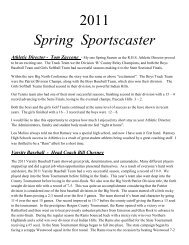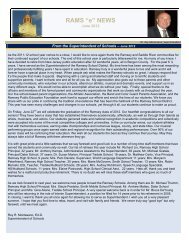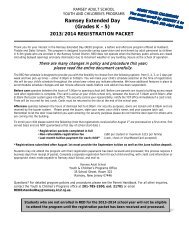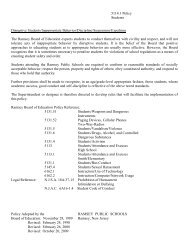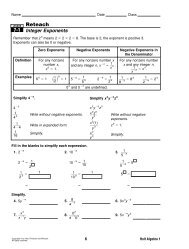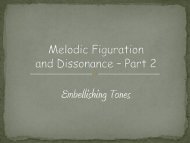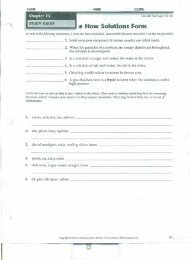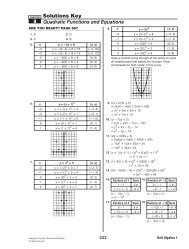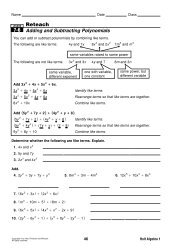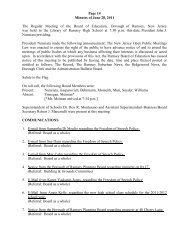Pre-Algebra Chapter 6 - Ramsey School District
Pre-Algebra Chapter 6 - Ramsey School District
Pre-Algebra Chapter 6 - Ramsey School District
Create successful ePaper yourself
Turn your PDF publications into a flip-book with our unique Google optimized e-Paper software.
Reading Math<br />
P(prime)<br />
P(prime) is read as the<br />
probability of rolling<br />
a prime number.<br />
Example 1<br />
Find Probability<br />
Suppose a number cube is rolled. What is<br />
the probability of rolling a prime number?<br />
There are 3 prime numbers on a number cube:<br />
2, 3, and 5.<br />
There are 6 possible outcomes: 1, 2, 3, 4, 5, and 6.<br />
number of favorable outcomes<br />
P(prime) <br />
number of possible outcomes<br />
3 6 or 1 2 <br />
So, the probability of rolling a prime number is 1 or 50%.<br />
2<br />
The set of all possible outcomes is called the sample space. For Example 1,<br />
the sample space was {1, 2, 3, 4, 5, 6}. When you toss a coin, the sample space<br />
is {heads, tails}.<br />
Example 2<br />
Find Probability<br />
Suppose two number cubes are rolled. Find the probability of rolling an<br />
even sum.<br />
Make a table showing the sample space when rolling two number cubes.<br />
1<br />
2<br />
3<br />
4<br />
5<br />
6<br />
1 2 3 4 5 6<br />
(1, 1) (1, 2) (1, 3) (1, 4) (1, 5) (1, 6)<br />
(2, 1) (2, 2) (2, 3) (2, 4) (2, 5) (2, 6)<br />
(3, 1) (3, 2) (3, 3) (3, 4) (3, 5) (3, 6)<br />
(4, 1) (4, 2) (4, 3) (4, 4) (4, 5) (4, 6)<br />
(5, 1) (5, 2) (5, 3) (5, 4) (5, 5) (5, 6)<br />
(6, 1) (6, 2) (6, 3) (6, 4) (6, 5) (6, 6)<br />
There are 18 outcomes in which the sum is even.<br />
So, P(even sum) 1 8<br />
or 1 36<br />
2 .<br />
This means there is a 50% chance of rolling an even sum.<br />
The probabilities in Examples 1 and 2 are called theoretical probabilities.<br />
Theoretical probability is what should occur. Experimental probability is<br />
what actually occurs when conducting a probability experiment.<br />
Example 3<br />
Find Experimental Probability<br />
The table shows the results of an<br />
Outcome Tally Frequency<br />
experiment in which a coin was tossed.<br />
Heads |||| |||| |||| 14<br />
Find the experimental probability of<br />
Tails |||| |||| | 11<br />
tossing a coin and getting tails for this<br />
experiment.<br />
number of times tails occur 11<br />
11<br />
or <br />
number of possible outcomes 14 11 2 5<br />
11 The experimental probability of getting tails in this case is or 44%.<br />
2 5<br />
www.pre-alg.com/extra_examples<br />
Lesson 6-9 Probability and <strong>Pre</strong>dictions 311



